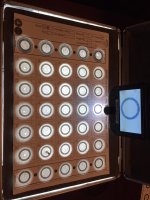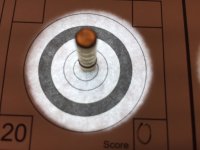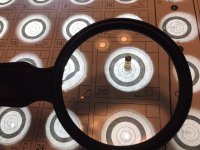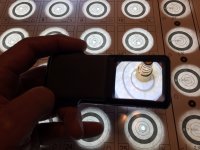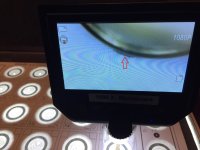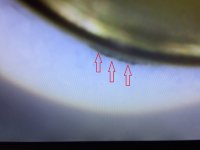Hello Members:
I have a question for the experts in scoring BR targets: What is the correct power magnification (loupe/magnifier) for scoring?
If we were talking about diamonds, jewelers and the jewelry industry have set a 10X magnifier as the standard, if no flaws are seen at 10X then the diamond is considered "Flawless", nevertheless you will see flaws when more than 10X is used.
For scoring our BR targets we have an illuminated perfectly leveled box so the plug is always perpendicular to the target, we use a handheld 8X magnifier and a 5X Carson mini-brite illuminated magnifier with the brass plug that USARB kindly provided us, but then we also have a digital microscope with a large screen that goes from 60X to 1000X.
The issue here is that with 5X it is possible to see some of "The Black" that is not seen with the naked eye and this is OK so far, this is not an "X"...Moving to another "X" NO black is seen with the 5X illuminated magnifier nor with the 8X, but using the digital microscope at any power level from 60-1000X we can see 2-3 black pixels to the sides of the USARB scoring plug...In theory, the "X" is not fully obliterated and this is not an "X, but it is an "X" if we use either of the other 2 magnifiers...
To complicate matters more, the high magnification of the microscope clearly shows that the printing on the cards is obviously not perfect nor homogeneous, some rings have more pixels or are slightly wider/narrower than others...
This situation tells me the need to have the scoring magnifiers homologated (in power) but I don't see anything talking about this issue in the current 2021 regulations...
Having said this, l kindly ask Joe Friederick, Ron Silveira, Steve Ware, Tom Price, Dick Strever, Mike Aber, Chas and all of those top shooters and people verifying the USARB records to please step in and provide your inputs...Maybe this issue needs world (Federation) attention ??
Regards for all members,
AZ
I have a question for the experts in scoring BR targets: What is the correct power magnification (loupe/magnifier) for scoring?
If we were talking about diamonds, jewelers and the jewelry industry have set a 10X magnifier as the standard, if no flaws are seen at 10X then the diamond is considered "Flawless", nevertheless you will see flaws when more than 10X is used.
For scoring our BR targets we have an illuminated perfectly leveled box so the plug is always perpendicular to the target, we use a handheld 8X magnifier and a 5X Carson mini-brite illuminated magnifier with the brass plug that USARB kindly provided us, but then we also have a digital microscope with a large screen that goes from 60X to 1000X.
The issue here is that with 5X it is possible to see some of "The Black" that is not seen with the naked eye and this is OK so far, this is not an "X"...Moving to another "X" NO black is seen with the 5X illuminated magnifier nor with the 8X, but using the digital microscope at any power level from 60-1000X we can see 2-3 black pixels to the sides of the USARB scoring plug...In theory, the "X" is not fully obliterated and this is not an "X, but it is an "X" if we use either of the other 2 magnifiers...
To complicate matters more, the high magnification of the microscope clearly shows that the printing on the cards is obviously not perfect nor homogeneous, some rings have more pixels or are slightly wider/narrower than others...
This situation tells me the need to have the scoring magnifiers homologated (in power) but I don't see anything talking about this issue in the current 2021 regulations...
Having said this, l kindly ask Joe Friederick, Ron Silveira, Steve Ware, Tom Price, Dick Strever, Mike Aber, Chas and all of those top shooters and people verifying the USARB records to please step in and provide your inputs...Maybe this issue needs world (Federation) attention ??
Regards for all members,
AZ
Last edited:


